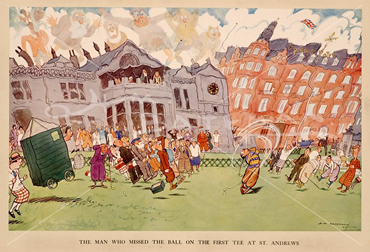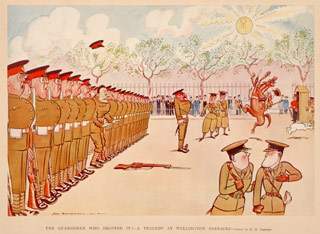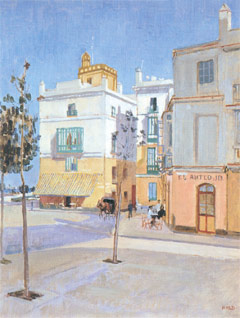



H M Bateman 1887 - 1970
20th century cartoonist and caricaturist
To many admirers of the art of the cartoon, H.M.Bateman is the most original, the most various, the most brilliant – and, indeed, the funniest – genius of his times. Born in 1887, he was already drawing for publication in his early teens. Astonishingly prolific and inventive, everything he saw became material, so that his work can be read as a social history of Britain in the first half of the 20th Century and, to an extraordinary degree, as a kind of autobiography. His family and friends; his trips to the fair, to the seaside, abroad; his passions for the Music Hall, for tap-dancing, for boxing, for fishing, for golf; his desperate experiences in the First World War; his car, his house, his vacuum-cleaner; his triumphs and disasters over many years – all find their way in to his cartoons.
 |
His style developed and changed radically over the years. From the graceful and rhythmical lines of his earlier work to the stark brilliance of his strip cartoons and the furious energy of his “Man Who ...” series, his essential qualities of superb draughtsmanship, astonishing observation and a profound appreciation of humanity’s foibles, are always married to a wonderful wit and narrative perfection. He told marvellously funny stories in pictures. He made three great and radical contributions to the art of the cartoon in this country. The first came in 1908 when, aged 21, he suffered a nervous breakdown probably caused by the dreadful choice he had to make between pushing forward with his career as a cartoonist, already much in demand, or trying to become a “serious” painter. |
This derangement, coupled with an absolute devotion to the surreal madness of Music Hall comedians, seems to have given him a new intensity, a highly charged way of working. At a stroke he did away with the conventional stillness – not to say stiffness - of cartoon figures and, as he himself put it, “went mad on paper”. Until this time conventional cartoons had been illustrated jokes – drawings with a few lines of text or dialogue underneath. Take away the dialogue and the drawing becomes meaningless, the joke lay in the words. From 1909 onwards Bateman drew no more illustrated jokes and so changed profoundly the art of the cartoon, invested it with a new freedom of line and expression. The drawing became funny in itself, self-explanatory. He made emotion the subject of his cartoons and the characters became actors expressing feeling, rather than illustrations to an idea. This was a new, histrionic, hyperbolic creative method and its effects are still apparent amongst some of our greatest cartoonists today.
The second great and innovative contribution Bateman made to the art of the cartoon came during the First World War. He had been rejected by the army and retreated ill and deeply depressed to a remote inn on Dartmoor. But he worked prodigiously and started to produce, in 1916, astonishing strip cartoons that immediately gripped the public and the attention of his fellow artists. As a child he had been an avid reader of the new comic papers and these were, of course, full of comic strips. But these stories and adventures, full of invention and wonderful comic characters though they were, relied again on the story underneath, or speech-bubbles within, and were childish and simple. What Bateman did was to create self-contained strip cartoons without words, brilliant, innovative, cinematic comic stories, adult, often harsh and macabre, and frequently – at this period – to do with themes of guilt, punishment, retribution and death. Cartoons like The Boy Who Breathed on the Glass at the British Museum, The Guest Who Filled his Fountain Pen with Hotel Ink or Mexicans at Play are all wonderfully humorous but also harsh and complex and they come as a tremendous shock amongst the predictable pages of Punch or The Tatler. Nothing like them had been seen in this country before.
|
His third major influence on the history of the cartoon came in 1921 and continued for many years. It is, perhaps, the most famous of all his contributions and profoundly changed the landscape of humorous art: he started on his great series of “Man Who” cartoons. Looking back through his work it is apparent that he had been playing with this idea for many years, but the publication of The Guardsman Who Dropped It by the Tatler as a full colour centre -spread caused a sensation and engendered a series of cartoons that lasted for the rest of Bateman’s career. The majority of the Man Who cartoons describe some terrible social misdemeanour, some solecism or offence against accepted custom and behaviour. |
 |
They contain those repeated descriptions of anger, consternation and disgust that became the hallmarks of the Bateman cartoon: eyeballs popping out of sockets, contorted bodies, figures prone or airborne. The protagonist is shown recoiling in horror from his actions and the attention focused on him, or else blithely carrying on, innocent of the outrage he has perpetrated and the world’s indignant roar. And the cartoons single out for scrutiny not only the individual who has caused such offence but, perhaps more interestingly, the society that condemns him.
 |
Bateman became the most highly paid cartoonist in the country, sought after by advertisers, engaged in America and Australia, published in Europe. All this time, certainly until the late 1920s, he was producing his brilliant strip cartoons and a huge amount of other work in many different and interesting styles, but the Man Who cartoons came to define him, captured the public imagination and passed into the mythology of the nation. These are still in great demand and hardly a week goes by to this day without someone in the press referring to a “Bateman situation”. Astonishingly, right at the height of his fame, still in his forties, a few years before the Second World War, Bateman gave up all humorous art completely and slipped off quietly, alone, to pursue his old dream of becoming a “serious painter”. He died in his 84th year, still painting every day, out walking in the sunshine on Gozo, where he had lived simply and modestly in a quiet hotel, in the room with the finest view. |
| ------------------------------------------------------------------------------------------------------ |
||
| The Strip Cartoons of H. M. Bateman: In 1916 H.M.Bateman started to publish his extraordinary, revolutionary, strip cartoons. These were strips without words, wonderful cinematic sequences that relied only upon the story that the drawings told and did away with any explanatory text. Nothing like them had been seen in Britain before. Coming across them in the pages of Punch or the Tatler is almost shocking – they were so vivid, new and different. In their vigour, their expressiveness and their form they are utterly distinct from any other work of the time. |
||
 |
||
|
|
||